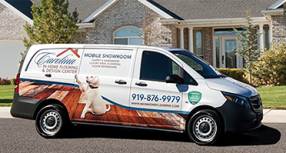What should you ask if you want genuine hardwood flooring?
Two kinds of hardwood floors are available today. One is solid and the other is engineered. Solid is a single piece that is 100% solid wood that is sanded easily and can be refinished. Also a 100% wood product, “engineered” is a product that results in higher-performance. It is created when numerous layers of wood are bonded together with the feature wood showing. Most engineered wood floors can be refinished. All have renewable finished which can be recoated an unlimited number of times.
How do you know where to start?
Think like a designer. Think color. Yes, wood has color, too. Each species (whether or not it is stained) has a color ranging from cool (yellows) to warms (reds) and neutrals (umbers or naturals). Some woods change color over time; that’s natural, often desirable (like antique furniture). Grain provides texture and interest.
What about gloss?
You can have low gloss, satin gloss or high gloss, but gloss has nothing to do with durability or performance. What we are talking about here is the look. The look may be smooth or hand-scraped and rustic or a contemporary style that is tailored. (Lower gloss can help hide scratches, though.) How you show off your floor depends on lighting. The three types, general, spot and recessed, impact your floor’s appearance in different ways.
Where can I use hardwood flooring?
Pretty much anywhere or through the whole house. Solid is recommended at or above ground level due to sensitivity to moisture. Engineered can be used virtually anywhere, even over concrete. Using solid where wood subfloors exist and engineered in moisture-prone areas means you can have one wood species running through the entire house.
How do I get a stunning wood floor?
After color, think species which means grain and shadings and often, hardness. Not all hardwoods are equally hard. Compare formats – strips (usually under 3 inches wide) or planks (over 3 inches), and check the edge detail. Do you want square, beveled, something in the middle? Don’t forget trim and moldings. They are the finishing details. Follow manufacturers’ instructions on cleaning materials and scheduled maintenance.








